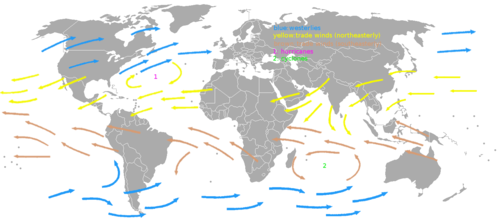Difference between revisions of "Issues in Flight Analysis"
Tom Bishop (talk | contribs) |
Tom Bishop (talk | contribs) |
||
| Line 71: | Line 71: | ||
==Easterly and Westerly Wind Directions== | ==Easterly and Westerly Wind Directions== | ||
| − | [https://en.wikipedia.org/wiki/Trade_winds Maps of the Trade-winds] show that winds can travel in both Easterly and Westerly directions: | + | [https://en.wikipedia.org/wiki/Trade_winds Maps of the Trade-winds] show that winds can travel in both Easterly and Westerly directions in the Northern and Southern Hemispheres: |
[[File:Map_prevailing_winds_on_earth.png|500px]] | [[File:Map_prevailing_winds_on_earth.png|500px]] | ||
Revision as of 22:57, 1 May 2020
Listed Flight Times Skewed
Why Flights Take Longer
http://www.travelandleisure.com/travel-tips/airlines-airports/why-flights-take-longer (Archive)
“ Did you know that a flight from New York City to Houston, Texas is over an hour longer today than if you took the same flight in 1973? Now it takes about three hours and 50 minutes, but 43 years ago it would have taken 2 hours and 37 minutes. What gives?
~
Surprisingly, flight time is calculated from when the aircraft releases the parking brake (on push back) to when it sets the brake on arrival to the gate,” commercial pilot Chris Cooke told Travel + Leisure. “All that waiting in line during taxi and takeoff counts toward flight time.
Not surprisingly, saving money is another reason flights take longer today. “Airlines are able to save millions per year by flying slower," reveals a video from Business Insider. ”
Are You Being Told the Truth about Flight Times?
A study which says they are skewing flight times:
https://www.telegraph.co.uk/travel/travel-truths/Are-airlines-exaggerating-flight-times-so-theyre-never-late/ (Archive)
Are you being told the truth about flight times?
“ Passenger jets have never been more advanced. With Boeing’s 787 Dreamliner, introduced in 2011, leading the charge, and new models like the 737 MAX and the Airbus A320neo following in its wake, the aircraft on which we travel are safer, smoother, quieter and more fuel efficient than ever.
They also appear perfectly capable of flying faster than their predecessors. Just last month the low-cost carrier Norwegian issued a celebratory press release after one of its 787 Dreamliners whizzed from John F. Kennedy International Airport in New York to London Gatwick in five hours and 13 minutes, setting a new transatlantic record for a subsonic plane. That’s three minutes quicker than the previous best time set by British Airways in January 2015.
So why, record-breaking feats notwithstanding, are airlines claiming it takes longer and longer to fly from A to B?
That’s according to research by OAG, the aviation analyst, carried out for Telegraph Travel. It found that over the last couple of decades, despite new technology, scheduled flight times - ie. how long an airline estimates it will take to complete a journey - have actually increased by as much as 50 per cent.
Looking at Europe’s busiest international route, for example - Heathrow to Dublin - it found that in 1996 the vast majority of airlines published a scheduled flight time of between 60 and 74 minutes. Fast forward 22 years and almost all claim the journey takes between 75 and 89 minutes, while a handful bank on 90 minutes or more. ”
Jet Streams
1001 Questions
1001 Questions Answered About Hurricanes, Tornadoes, and Other Natural Air Disasters
“ Jet streams are ever-present, relatively narrow, streams of high-speed winds undulating around the Northern and Southern Hemispheres. ...Within these streams, winds travel at different rates of speed, from some 50 miles per hour at the outer edges of the stream, to some 250 miles per hour at the center. Speeds as high as 300 miles an hour have been reported. ”
Jetstreams Enable Routine Supersonic Flight
Riding a Wild Wind, Transatlantic Jets Fly Faster Than Ever Archive)
A 200-mph jet stream has sent several passenger jets to nearly 800 mph and helped break a (subsonic) speed record.
“ OK, about that "subsonic" bit. You might know that the speed of sound at an altitude of 30,000 to 40,000 feet is roughly 670 mph. But Norwegian’s planes didn't break the sound barrier. Those near-800-mph figures represent ground speed—how fast the aircraft is moving over land. Their air speed, which factors out the 200-mph wind boost, was closer to the 787's standard Mach 0.85. (The older Boeing 747 can cruise at Mach 0.86, but is less efficient than its younger stablemate.) When talking supersonic, and breaking sound barriers, it's all about the speed of the air passing over the wings, which in this case was more like 570 mph. ”
Winds over the Southern Oceans
Australian Antarctic Division
http://www.antarctica.gov.au/magazine/2001-2005/issue-4-spring-2002/feature2/what-is-the-southern-ocean (Archive)
“ The Southern Ocean is notorious for having some of the strongest winds and largest waves on the planet. ”
BBC Earth
http://www.bbc.com/earth/story/20151009-where-is-the-windiest-place-on-earth (Archive)
“ There are huge belts of wind caused by the uneven way the Sun heats the Earth's surface. 30° north and south of the equator, the trade winds blow steadily. At 40° lie the prevailing westerlies, and the polar easterlies begin at around 60°.
Ask any round-the-world sailor and they will quickly tell you the stormiest seas, stirred by the strongest winds, are found in the Southern Ocean. These infamously rough latitudes are labelled the "roaring 40s", "furious 50s" and "screaming 60s". ”
Journal of Geophysical Research
https://agupubs.onlinelibrary.wiley.com/doi/full/10.1029/2003JD004179 (Archive)
“ The Southern Ocean is a vital element in the global climate. Its circumpolar current plays a crucial role in the global transport of mass, heat, momentum, and climate signals from one ocean basin to another. Moreover, the Southern Ocean hosts the strongest surface winds of any open ocean area, fostering strong heat, moisture, and momentum exchanges between the ocean and atmosphere. However, the Southern Ocean is tremendously undersurveyed by traditional observation methods because of the remoteness of the area and rough environment, causing the largest data gap of global oceans. ”
Easterly and Westerly Wind Directions
Maps of the Trade-winds show that winds can travel in both Easterly and Westerly directions in the Northern and Southern Hemispheres:

